

Egg in a Bottle – Air Pressure Experiment
- April 21, 2021
- 10 Minute Science , 7-9 Year Olds , Physics
Science is amazing as it does wonders in our real life and around the world.
Today, Let’s explore “Egg in a Bottle”, which proves using simple science concepts anyone can put an egg into a bottle without touching it.
Yes, the egg can move into a bottle without any external help but with the help of science.
Objectives in this Science Activity
Using this experiment, children can learn,
1) Relation between Temperature and Pressure
2) Impact of air pressure on objects
3) Impact of air pressure in our daily activities
4) Properties of air
Amazed! Yes, though the experiment is quick and simple, it carries a lot of scientific information to inspire young scientists.
Egg in a Bottle – Experiment
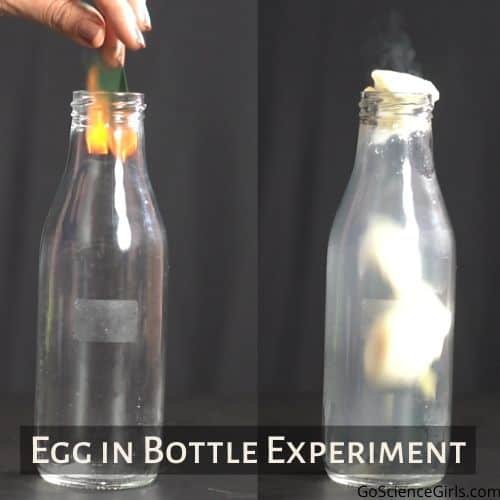
Supplies required
1) One glass container or jar. Make sure the opening of the glass jar is smaller than the size of a boiled egg because to fit the egg perfectly instead of slipping into the jar easily. Milk and Juice bottles work well for this purpose.
2) A small piece of Paper
3) Fire source i.e. a candle or lighter or a matchbox
4) One or two boiled eggs
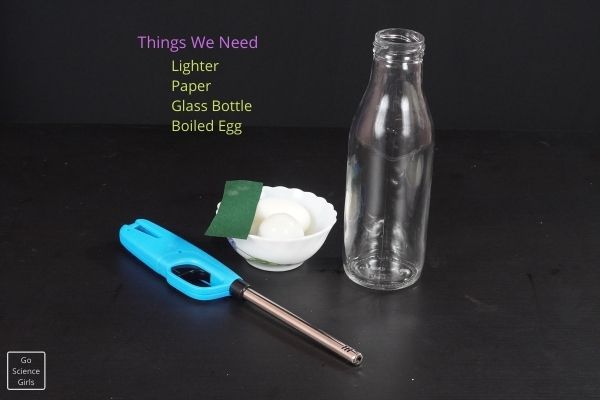
Preparations
Just before the experiment, pick fresh and raw eggs and boil them until they turn hard. Probably, this step takes 7-10 minutes.
Once boiled, peel off the outer shell part of the boiled egg and wash it under tap water to remove any hard remnants attached to the egg. Then, keep it aside on the experiment table.
Simple Step by Step Instructions
Step-1: Place a clean and transparent glass jar on the experiment table.
And then pick a piece of paper and burn it using a lighter. Please make sure the paper is folded into a strip such that it is easy for you to drop it into the jar bottle.
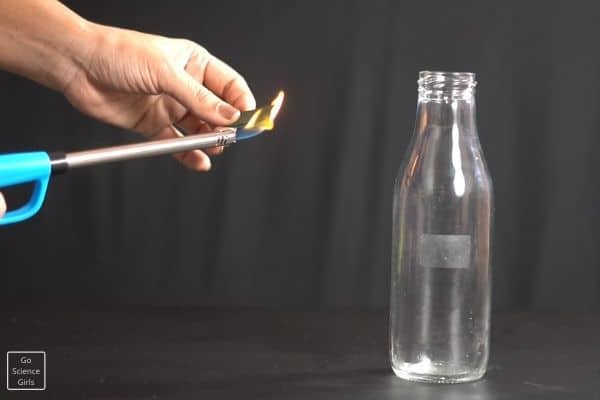
Step-2: When the paper catches fire, immediately drop it into the glass jar placed on the work table. You must drop the burning paper into the jar before the fire goes off.

Step-3: Now, Place the hard-boiled egg on top of the glass jar opening perfectly. Then observe the results.
Results: You will observe the egg slowly moving into the bottle. At times, the egg will go into the glass bottle as it is without any breakages, but sometimes it may spill while squeezing into the bottle.
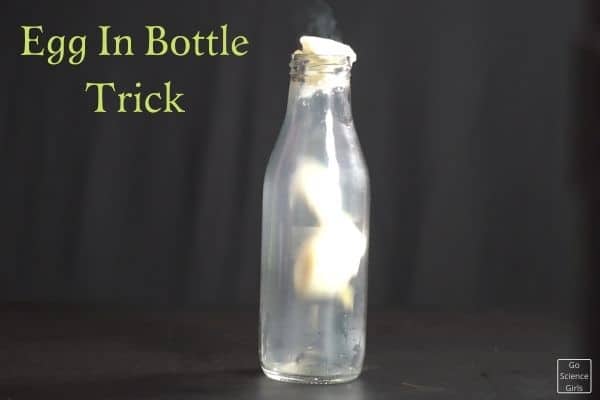
Note: If your egg fails or feeling difficult to slip down into the bottle, then you can apply vegetable oil around the neck of the bottle. Greasing oil helps the egg to move into the bottle easily.
Are you surprised watching an egg going into the bottle without any help from external forces? Do you want to learn that magical science trick? Then, let us discuss how this simple science activity worked out very well.
The Science Concepts behind The Egg in a Bottle Experiment
Air is a matter of substance, and hence it contains weight and other assets like density and pressure.
Generally, the air surrounding us or objects does not show any pressure because it surrounds with equal pressure.
But when there is additional pressure in the air, it starts showing its pressure through moving objects by push and pull trials.
In this science activity, we will observe that air shows its pressure when the opportunity is given.
Egg moving into the bottle without touching by external sources proves that air pressure is acting upon it. Let us discuss it in detail.
Before the experiment begins, the pressure of the air surrounding and inside the jar is the same as it is equally distributed.
That means the pressure inside and outside the glass bottle is the same at the beginning of the experiment.
But when we placed the burning paper into the glass bottle, the air inside the jar starts to expand. Because air molecules expand when it gets warmed up, and this is the specific characteristic of air.
And as soon as the egg is placed upon the opening of the glass bottle, the fire goes off, and the air molecules begin to cool down.
As the air molecules cool down, they start contracting themselves by lowering the air pressure inside the glass bottle.
That means there is a difference in the air pressure existing inside and outside the glass bottle.
Because there is less air pressure inside the bottle. The egg slowly squeezes into the bottle as the outside pressure pushes it from outside.
Yes, when the air molecules inside the bottle cool down, it offers more space to welcome additional air molecules.
In this process, the outside air molecules rush into the bottle to fill the spaces. So, it keeps pressure on the egg and helps it slip down into the bottle.
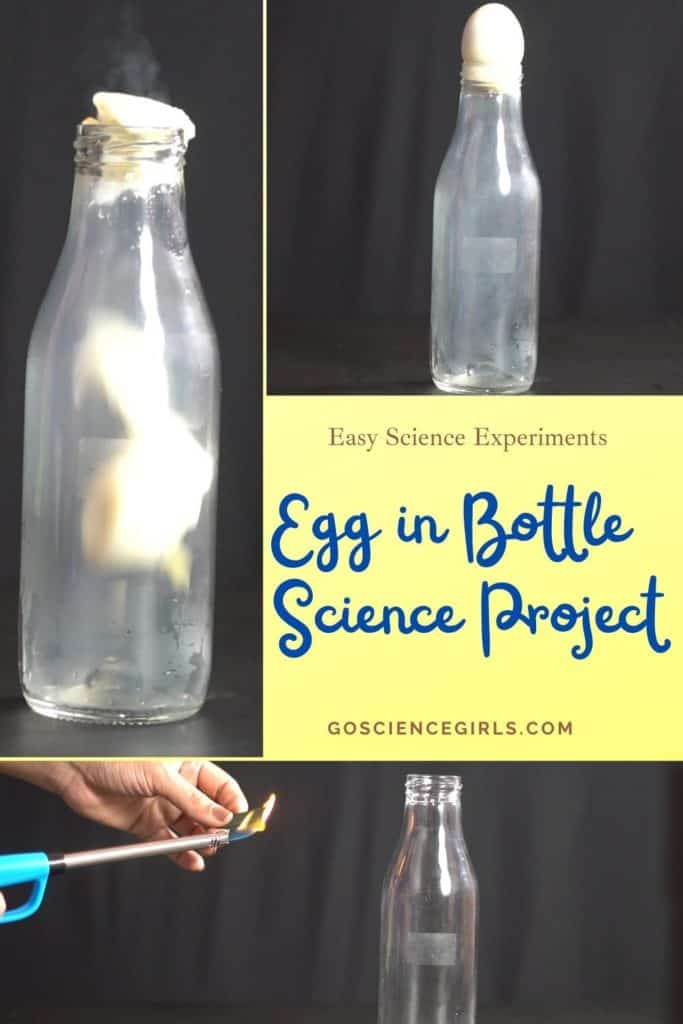

Extension Ideas
You can try out the experiment using other supplies such as boiling water and a balloon.
1) Use boiled water instead of paper inside the bottle and do the experiment
2) Try out using an inflated balloon filled with water in the place of a boiled egg.
Interesting Air Pressure Activities for Kids
Balloon in a Bottle
Crushing Can Experiment
Drip Drop Water Bottle – Science Behind Water Dispenser
Balloon in Hot and Cold Water
Tips to Teacher s
Here are the important questions a teacher can ask to make the students involved completely during the experiment. And to encourage them to participate in revealing and understanding the science behind the experiment.
1) What made an egg move into the bottle without touching it?
2) Why only eggs must be used in this science activity?
3) Are there any other possibilities to change the pressure of the air inside and outside the bottle?
4) Will the egg come out of the bottle again? If Yes, How?
5) What are the properties of air that made the egg move into the bottle?
Safety Measures
As we are dealing with fire, children need to be very careful while performing this activity. It is better to put on their safety guards even though an adult or teacher performs the activity. Adult supervision is a must when a child is performing this activity on his/her own.
Leave a Reply Cancel Reply
Your email address will not be published. Required fields are marked *
Name *
Email *
Add Comment *
Save my name, email, and website in this browser for the next time I comment.
Post Comment
- Science, Tech, Math ›
- Chemistry ›
- Projects & Experiments ›
Egg in a Bottle Demonstration
The Power of Air Pressure
- Projects & Experiments
- Chemical Laws
- Periodic Table
- Scientific Method
- Biochemistry
- Physical Chemistry
- Medical Chemistry
- Chemistry In Everyday Life
- Famous Chemists
- Activities for Kids
- Abbreviations & Acronyms
- Weather & Climate
- Ph.D., Biomedical Sciences, University of Tennessee at Knoxville
- B.A., Physics and Mathematics, Hastings College
The egg in a bottle demonstration is an easy chemistry or physics demonstration you can do at home or in the lab. You set an egg on top of a bottle (as pictured). You change the temperature of the air inside the container either by dropping a piece of burning paper into the bottle or by directly heating/cooling the bottle. Air pushes the egg into the bottle.
- Peeled hard-boiled egg (or soft-boiled, if a yolky mess interests you)
- Flask or jar with an opening slightly smaller than the diameter of the egg
- Paper/lighter or very hot water or very cold liquid
In a chemistry lab , this demonstration is most commonly performed using a 250-ml flask and a medium or large egg. If you are trying this demonstration at home, you can use a glass apple juice bottle. If you use too large of an egg, it will get sucked into the bottle, but stuck (resulting in a gooey mess if the egg was soft-boiled). We recommend a medium egg for most bottles. An extra-large egg gets wedged in the bottle.
Perform the Demonstration
- Method 1 : Set a piece of paper on fire and drop it into the bottle. Set the egg on top of the bottle (small side pointed downward). When the flame goes out, the egg will get pushed into the bottle.
- Method 2 : Set the egg on the bottle. Run the bottle under very hot tap water. Warmed air will escape around the egg. Set the bottle on the counter. As it cools, the egg will be pushed into the bottle.
- Method 3 : Set the egg on the bottle. Immerse the bottle in a very cold liquid. We have heard of this being done using liquid nitrogen , but that sounds dangerous (could shatter the glass). We recommend trying ice water. The egg is pushed in as the air inside the bottle is chilled.
How It Works
If you just set the egg on the bottle, its diameter is too large for it to slip inside. The pressure of the air inside and outside of the bottle is the same, so the only force that would cause the egg to enter the bottle is gravity. Gravity isn't sufficient to pull the egg inside the bottle.
When you change the temperature of the air inside the bottle, you change the pressure of the air inside the bottle. If you have a constant volume of air and heat it, the pressure of the air increases. If you cool the air, the pressure decreases. If you can lower the pressure inside the bottle enough, the air pressure outside the bottle will push the egg into the container.
It's easy to see how the pressure changes when you chill the bottle, but why is the egg pushed into the bottle when heat is applied? When you drop burning paper into the bottle, the paper will burn until the oxygen is consumed (or the paper is consumed, whichever comes first). Combustion heats the air in the bottle, increasing the air pressure. The heated air pushes the egg out of the way, making it appear to jump on the mouth of the bottle. As the air cools, the egg settles down and seals the mouth of the bottle. Now there is less air in the bottle than when you started, so it exerts less pressure. When the temperature inside and outside the bottle is the same, there is enough positive pressure outside the bottle to push the egg inside.
Heating the bottle produces the same result (and may be easier to do if you can't keep the paper burning long enough to put the egg on the bottle). The bottle and the air are heated. Hot air escapes from the bottle until the pressure both inside and outside the bottle is the same. As the bottle and air inside continue to cool, a pressure gradient builds, so the egg is pushed into the bottle.
How to Get the Egg Out
You can get the egg out by increasing the pressure inside the bottle so that it is higher than the pressure of the air outside of the bottle. Roll the egg around so it is situated with the small end resting in the mouth of the bottle. Tilt the bottle just enough so you can blow air inside the bottle. Roll the egg over the opening before you take your mouth away. Hold the bottle upside down and watch the egg fall out of the bottle. Alternatively, you can apply negative pressure to the bottle by sucking the air out, but then you risk choking on an egg, so that's not a good plan.
- 10 Cool Chemistry Demonstrations for Educators
- Elephant Toothpaste Chemistry Demonstration
- Create a Magic Genie in a Bottle Effect (Chemistry)
- Color Change Chemistry Experiments
- Cloud in a Bottle Demonstration
- The Blue Bottle Chemistry Demonstration
- Crystal Easter Egg Science Project
- 10 Fun Chemistry Demonstrations and Experiments
- Take Your Volcano Science Project to the Next Level
- Make Potassium Chlorate from Bleach and Salt Substitute
- A Dental Health Activity With Eggshells and Soda
- Things to Do with Liquid Nitrogen
- 10 Cool Chemistry Experiments
- How to Make Glow in the Dark Mountain Dew
- How to Do the Color Change Chameleon Chemistry Demonstration
- How to Do the Barking Dog Chemistry Demonstration

IMAGES
VIDEO